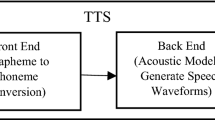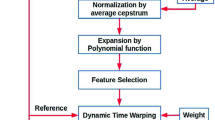Abstract
This paper proposes a voice synthesizer to convert a single speech to multiple speeches. Pitch is an important voice characteristic of speech parameter and it is produced by the periodic vibration of the vocal-cords; the parameter most sensitive for human’s auditory sense. So if you change the pitch of the voice with several different scaling rates, you can produce several different voices at the same time with a voice. The Multiple-Speech Synthesizer will be used in diverse practical applications. The cheer synthesizer that makes group voice from a single voice would be such an example. You could also use the system for a troll toy, birthday song tracks, effect sounds in movies and plays, protection systems of houses, etc. Furthermore, the synthesizer could be used to imitate the voice of famous entertainers or cartoon characters, such as the Mask-man.
Similar content being viewed by others
References
Bastien P. (2001). Pitch shifting and voice transformation techniques. TC-Helicon Vocal Technologies, http://www.tc-helicon.com.
Gold E., Morgan N. (2000) Speech and audio signal processing. Wiley, New York
Iida, A., et al. (2000). A speech synthesis system with emotion for assisting communication. In Proceedings of ICSA Workshop on Speech and Emotion (pp. 167–177).
Keller E. et al. (2002). Improvement in speech synthesis. Wiley, New York
Kim J.K., Jo W.R., Bae M.J. (2003) A study on real time prosody control of speech. CCCT 2003(5): 195–198
Kim, J. K., Na, D. S., & Bae, M. J. (2007). On a pitch alteration technique in transformation domain of speech signals. In International Conference on Life System Modelling and Simulation 2007 (Vol. 14, pp. 522–526). Watam Press.
Mitra S. (2001) Digital signal processing, a computer-based approach. McGraw-Hill, New York
Park H.B., Bae M.J. (2000) On a detection of pitch point for voice color conversion. Journal of the Acoustical Society of Korea & World Affairs 19(1): 49–152
Seo J.H., Bae M.J. (2004) On a pitch alteration technique by sub-band scaling in speech signal. GESTS, GESTS International Transactions on Speech Science and Engineering 1(2): 112–120
Tse, M. (2003). Voice transformation. EE6820 Speech and Audio Processing Project Report, Columbia University.
Turk, O. (2003). New methods for voice conversion. M.S. Thesis, in Electrical and Electronics Engineering, Bogazici University.
Turk, O., & Arslan, L. M. (2002). Subband based voice conversion. In Proceedings of the ICSLP 2002 (Vol. 1, pp. 289–292).
Verhelst, W. (2000). Overlap-add methods for time-scaling of speech. Speech Communication, 30, 207–221, Elsevier Science.
Author information
Authors and Affiliations
Corresponding author
Rights and permissions
About this article
Cite this article
Kim, J.K., Hahn, H.S. & Bae, M.J. On a Speech Multiple System Implementation for Speech Synthesis. Wireless Pers Commun 49, 533–543 (2009). https://doi.org/10.1007/s11277-008-9575-1
Received:
Accepted:
Published:
Issue Date:
DOI: https://doi.org/10.1007/s11277-008-9575-1




